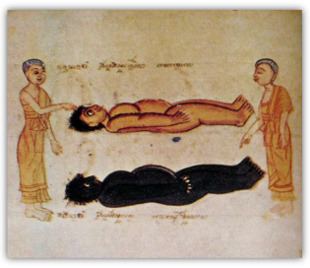[internal
confidence,
mental
unification] equani-
mous,
mindful | ||
 | ||
seclusion-
born;
pervades
body samādhi-
born;
pervades
body pervades
physical
body aban-
doned
(as is
pain) equani-
mous,
mindful mindfull;
neither
pleasure
nor pain | ||
In Buddhism, kammaṭṭhāna is a Pali word (Sanskrit: karmasthana) which literally means the place of work. Its original meaning was someone's occupation (farming, trading, cattle-tending, etc.). It has several distinct but related usages, all having to do with Buddhist meditation.
Contents
- Forty meditation subjects
- Meditation subjects and jhanas
- Meditation subjects and temperaments
- References
Its most basic meaning is as a word for meditation. In Burma senior meditation practitioners are known as "kammatthanacariyas" (meditation masters). Buddhaghosa uses "kammatthana" to refer to each of his forty meditation objects listed in the third chapter of the Visuddhimagga, which are partially derived from the Pāli Canon.
Forty meditation subjects
Of the forty objects meditated upon as kammatthana, the first ten are 'things that one can behold directly', 'kasina', or 'a whole':
The next ten are objects of repulsion (asubha):
Ten are recollections (anussati):
Four are stations of Brahma (Brahma-vihara):
Four are formless states (four arūpajhānas):
One is of perception of disgust of food (aharepatikulasanna).
The last is analysis of the four elements (catudhatuvavatthana): earth (pathavi), water (apo), fire (tejo), air (vayo).
Each kammatthana can be suggested, especially by a spiritual friend (kalyāṇa-mitta), to a certain individual student at some specific point, by assessing what would be best for that student's temperament and the present state of his or her mind.
Meditation subjects and jhanas
Of these, due to their complexity, eight recollections (excluding the recollection of the Body (kāyagatāsati) and of Breathing (ānāpānassati)), the perception of disgust of food and the analysis of the four elements only lead to access concentration (upacara samadhi).
Absorption in the first jhana can be realized by mindfulness on the ten kinds of foulness and mindfulness of the body. However, these meditations cannot go beyond the first jhana due to their involving applied thought (vitaka) which is absent from the higher jhanas.
Absorption in the first three jhanas can be realized by contemplating the first three brahma-viharas. However, these meditations cannot aid in attaining the fourth jhana due to the pleasant feelings associated with them. Conversely, once the fourth jhana is induced, the fourth brahma-vihara (equanimity) arises.
Due to the simplicity of subject matter, all four jhanas can be induced through mindfulness of breathing and the ten kasinas.
Meditation subjects and temperaments
All of the aforementioned meditation subjects can suppress the Five Hindrances, thus allowing one to fruitfully pursue wisdom. In addition, anyone can productively apply specific meditation subjects as antidotes, such as meditating on foulness to counteract lust or on the breath to abandon discursive thought.
The Pali commentaries further provide guidelines for suggesting meditation subjects based on one's general temperament:
The six non-color kasinas and the four formless states are suitable for all temperaments.
